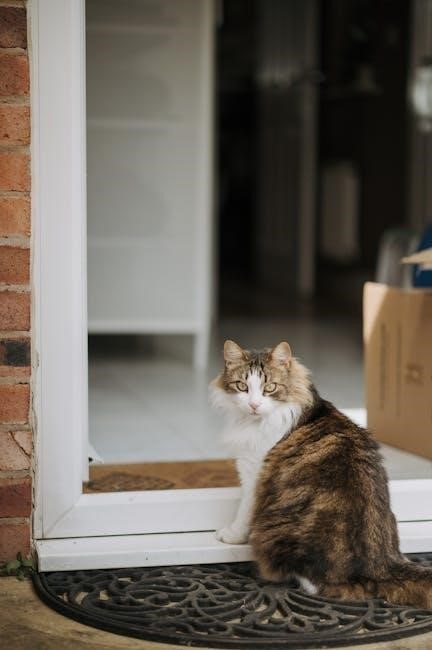Cat house plans offer a structured approach to building a safe and cozy shelter for your feline friend․ These plans come in various formats, with PDF being a popular choice due to its accessibility and detailed instructions, ensuring a successful build․
Why Build a Cat House?
Building a cat house provides vital shelter, especially for outdoor or feral cats, protecting them from harsh weather conditions like rain, snow, and extreme temperatures․ A well-constructed cat house offers a safe haven where cats can rest, sleep, and feel secure from potential threats․ Additionally, providing a dedicated space can help reduce stress and improve the overall well-being of your feline companions․ Using cat house plans PDF ensures a proper build․
Benefits of DIY Cat Houses
Building a cat house yourself offers numerous advantages, including cost savings compared to purchasing a pre-made structure․ DIY cat houses allow for customization, enabling you to tailor the design to your cat’s specific needs and preferences․ Using readily available cat house plans PDF, you can create a unique and personalized shelter․ This ensures that the materials used are safe and of high quality, promoting a sense of accomplishment and providing a comfortable space for your cat․
Types of Cat House Plans
Cat house plans cater to different needs․ These range from indoor models to outdoor shelters․ There are also insulated designs available in PDF format, providing warmth during colder months, ensuring your cat’s comfort․
Indoor Cat House Plans
Indoor cat house plans, often available as PDF downloads, focus on aesthetics and integration with home decor․ These plans frequently incorporate soft materials and playful designs, such as multi-level structures or cozy hideaways․ The emphasis is on creating a comfortable and stimulating environment for indoor cats․ Many designs also consider the cat’s scratching and climbing instincts, offering built-in features like scratching posts․ Ease of cleaning and maintenance is also a key factor in indoor cat house design, ensuring a hygienic space for your feline companion․
Outdoor Cat House Plans
Outdoor cat house plans, often found in PDF format, prioritize weather protection and durability; These plans emphasize sturdy construction using materials like treated wood or recycled plastic․ Designs typically include features like sloped roofs for water runoff and elevated floors to prevent dampness․ Many outdoor plans also offer insulation options for colder climates․ Camouflage or natural finishes help the cat house blend into the outdoor environment․ Considerations for safety from predators and easy access for cleaning are also essential elements in these plans․
Insulated Cat House Plans for Winter
Insulated cat house plans for winter are crucial for providing warmth and protection during cold months․ These plans, available in PDF, detail how to incorporate insulation materials like foam board or fiberglass into the structure․ Proper insulation helps retain heat and protect from freezing temperatures․ Plans often include features like small entrances to minimize heat loss and wind exposure․ Additional considerations are given to moisture control to prevent mold and mildew․ Some designs include heated pads or self-warming materials for extra comfort․

Free Cat House Plans PDF Resources
Discovering free cat house plans in PDF format is easier than you might think․ Numerous websites offer downloadable guides for various designs․ These resources provide cost-effective solutions for providing shelter to your feline companions․
Where to Find Free PDF Plans Online
The internet is a treasure trove for locating free cat house plans in PDF format․ Websites dedicated to woodworking, DIY projects, and animal welfare often provide these resources․ Online forums and communities related to cat care can also be excellent sources․ Always ensure the plans come from a reputable source to guarantee accuracy and safety in your construction project․ Consider checking sites associated with animal shelters and rescue organizations for reliable plans․
Considerations When Choosing a Free Plan
When selecting a free PDF cat house plan, several factors warrant attention․ Assess your skill level to ensure the plan’s complexity aligns with your abilities․ Examine the materials list to verify accessibility and affordability․ Consider the climate and opt for plans that offer insulation or weather protection if needed․ Prioritize plans that emphasize safety, avoiding sharp edges or toxic materials․ Verify the plan’s clarity and completeness before starting construction․ Ensure the plan is appropriately sized for your cat or cats․
Essential Features in Cat House Designs
Effective cat house designs prioritize comfort, safety, and weather protection․ Adequate ventilation, appropriate size, and non-toxic materials are crucial․ A well-designed cat house, built from a PDF plan, ensures a secure and pleasant environment․
Size and Dimensions for Comfort
When selecting a cat house plan PDF, carefully consider the size and dimensions to ensure your cat’s comfort․ The interior space should be large enough for the cat to turn around, stand up, and lie down comfortably․ A too-small space can cause anxiety, while an excessively large space may not retain heat effectively in colder climates․ Consider your cat’s size and habits, consulting the PDF plan for specific measurements that cater to your feline’s needs, guaranteeing a cozy and secure retreat․
Ventilation and Weather Protection
Adequate ventilation and robust weather protection are critical features to consider when evaluating a cat house plan PDF․ Proper ventilation prevents moisture buildup and ensures fresh air circulation, reducing the risk of respiratory issues․ The design should also shield the cat from rain, snow, and wind․ Overhangs, angled roofs, and strategically placed entrances can deflect harsh weather․ Look for PDF plans that incorporate these elements to create a safe, dry, and comfortable environment, protecting your feline friend from the elements year-round․
Safety Considerations
When choosing a cat house plan PDF, safety must be paramount․ Avoid designs with sharp edges, protruding nails, or small parts that could be ingested․ Ensure the entrance is appropriately sized to prevent predators from entering while allowing easy access for the cat․ The materials used should be non-toxic and weather-resistant․ Consider the stability of the structure, especially for outdoor models, to prevent tipping in strong winds․ A well-designed PDF plan will outline these precautions, guaranteeing a secure and harmless haven for your beloved pet․
Materials and Tools Needed
A typical cat house plan PDF will list necessary materials like wood, nails, and insulation․ Essential tools often include a saw, drill, hammer, and measuring tape for accurate construction and assembly․
Wood Choices: Plywood vs․ Solid Wood
When selecting wood for your cat house using a cat house plan PDF, consider plywood and solid wood․ Plywood is cost-effective, readily available, and resists warping, making it suitable for walls and roofs; Solid wood offers superior durability and aesthetic appeal, ideal for framing and structural elements․ Choose based on budget, desired lifespan, and the level of weather resistance needed for the cat house location․ Remember to treat the wood appropriately to protect it from the elements and prevent rot, ensuring a long-lasting and safe shelter for your feline companion․
Insulation Options for Cold Climates
For cat house plans PDF designed for cold climates, insulation is crucial․ Consider using rigid foam insulation, which provides excellent thermal resistance and is easy to cut and fit within the walls of the cat house․ Alternatively, fiberglass insulation can be used, but ensure it’s properly sealed to prevent moisture absorption and potential health hazards for your cat․ Reflective bubble insulation is another option, offering a lightweight and effective barrier against heat loss․ Choose an insulation material that is safe, durable, and appropriate for the climate to keep your cat warm and comfortable during winter․
Necessary Tools for Construction
When embarking on a cat house construction project using PDF plans, it’s essential to have the right tools․ A circular saw or jigsaw is needed for cutting wood accurately․ A drill with various bits will be necessary for creating pilot holes and driving screws․ A measuring tape, level, and square will ensure precise measurements and alignment․ Safety glasses and gloves are crucial for personal protection․ A hammer, sandpaper, and a utility knife will also come in handy for assembly and finishing touches, ensuring a safe and well-built cat shelter․

Step-by-Step Guide to Building a Basic Cat House
Follow these steps to construct a simple cat house using readily available PDF plans․ This guide will cover the essentials, from preparing materials to assembling the structure, providing a secure and comfortable space for your cat․
Cutting the Wood
Accurately cutting the wood is crucial for a well-constructed cat house․ Start by carefully reviewing your chosen PDF plan and identifying the dimensions for each piece․ Using a measuring tape, mark the cutting lines on your plywood or solid wood․ Employ a circular saw or jigsaw to make precise cuts, ensuring smooth edges․ Remember to wear safety glasses and gloves during this process․ Double-check each cut against the PDF plan measurements before proceeding to the assembly stage․ Proper cutting will make the assembly process much easier and result in a sturdier, more aesthetically pleasing cat house․
Assembling the Structure
Once all the wooden pieces are cut according to your cat house plan PDF, the next step is assembling the structure․ Begin by laying out the base and attaching the side walls using wood screws or nails, ensuring they are square and flush․ Then, attach the front and back pieces, again making sure everything is aligned correctly․ Follow the specific instructions in your PDF plan for the order of assembly and any additional supports needed․ Use wood glue in conjunction with screws or nails for added strength and stability․ Allow the glue to dry completely before moving on․
Adding a Roof and Finishing Touches
With the main structure assembled, it’s time to add the roof, referencing your cat house plan PDF for precise measurements and angles․ Secure the roof using screws or nails, ensuring a snug fit to protect against the elements․ Overhangs can provide extra shelter․ Once the roof is on, focus on finishing touches; Sand down any rough edges or splinters for safety․ Consider adding trim for a more polished look, following the details outlined in your chosen PDF plan․ Finally, apply a weather-resistant sealant or paint to protect the wood from moisture and extend the life of your cat house․

Customizing Your Cat House
Customizing elevates a basic structure into a personalized haven․ Using your cat house plans PDF as a foundation, explore options for unique features, ensuring the final product reflects your cat’s individual needs and preferences․
Adding a Cat Door
Incorporating a cat door into your cat house design, especially when following a cat house plans PDF, provides your feline with independent access․ When selecting a cat door, consider the size of your cat to ensure comfortable passage․ Weatherproof models are ideal for outdoor houses, keeping the elements at bay․ Proper installation, guided by your PDF plan, is essential to prevent drafts and maintain a secure, functional entrance for your beloved pet․ This small addition significantly enhances the cat’s comfort and freedom․
Painting and Decorating
Once your cat house is structurally sound, the fun part begins: painting and decorating! When following your cat house plans PDF, choose paints that are non-toxic and safe for animals․ Bright colors can make the house more inviting, while themed decorations can add a personal touch․ Consider adding stencils or paw print designs for a playful look․ Ensure all decorations are securely attached to prevent hazards․ Remember, the goal is to create a visually appealing and safe space for your feline companion to enjoy․
Including Scratching Posts or Other Features
Elevate your cat house project by incorporating additional features that cater to your cat’s natural instincts․ Many cat house plans PDF resources suggest integrating a scratching post, either on the side or inside the structure․ This encourages healthy scratching behavior and protects your furniture․ Consider adding multiple levels or platforms for climbing and perching․ Tunnels, dangling toys, or even a small feeding station can transform a simple shelter into a stimulating and engaging environment for your cat, making it a true haven․

Cat House Placement and Maintenance
Strategic placement and regular maintenance are crucial for ensuring your cat house remains a safe and inviting space․ Choosing the right location protects it from elements․ Simple cleaning keeps the space healthy․
Choosing the Right Location
Selecting the ideal spot for your cat house is vital for its utilization and longevity․ Opt for a sheltered area that provides protection from harsh weather conditions like wind, rain, and direct sunlight․ Consider placing it near a wall or fence for added security and a sense of enclosure․ Ensure the location is easily accessible for your cat and convenient for cleaning and maintenance․ A stable, level surface is a must to prevent tipping and ensure comfort․ Minimizing exposure to high-traffic areas will also reduce stress․
Cleaning and Upkeep
Regular cleaning and upkeep are crucial for maintaining a hygienic and inviting cat house․ Remove any soiled bedding or debris regularly to prevent the buildup of bacteria and odors․ Periodically wipe down the interior surfaces with a mild, pet-safe cleaner․ Check for any signs of damage, such as cracks or leaks, and address them promptly to prevent further deterioration․ Replace worn-out insulation or bedding to ensure continued comfort and warmth․ Maintaining the surrounding area will discourage pests and keep the space appealing for your cat․
Winterizing Tips
As winter approaches, preparing your cat house for the cold weather is vital for your cat’s comfort and safety․ Enhance insulation by adding extra layers of bedding, such as straw or blankets, within the shelter․ Ensure the entrance is protected from wind and snow, perhaps with a flap or a strategically placed barrier․ Check for and seal any drafts or gaps in the structure to retain heat․ Consider elevating the house off the ground to prevent moisture buildup and further insulate it from the cold ground․ Regularly clear snow from around the entrance․
